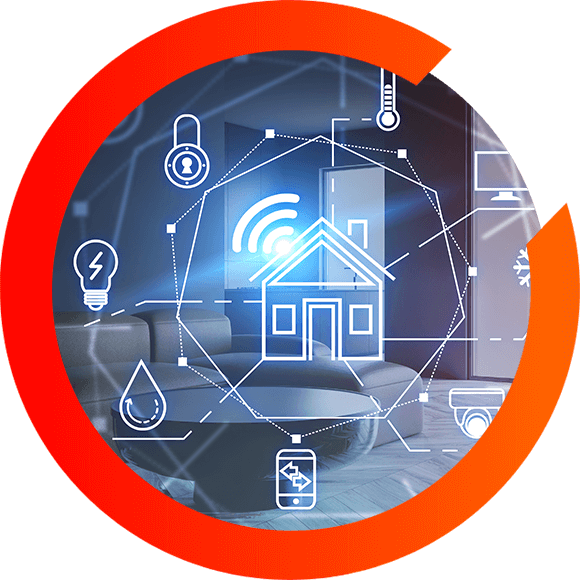Discover the new standard for developing and deploying connected home services
Building on the revolutionary practices of TR-069, the User Service Platform (USP) provides a faster and more flexible way to develop and deploy connected home devices.
From Managed Wi-Fi systems, bulk statistics collection, and standardized IoT onboarding to customer self-care applications and secure communication, USP helps service providers, consumer electronics manufacturers, and application developers create services with real value.
QA Cafe provides training resources to help you create the connected home services of the future.

USP training resourcesThe information you need to implement the User Services Platform (TR-369)
USP is a revolutionary standard that builds on the lessons learned from TR-069. In addition to being a faster and more flexible at meeting the existing use cases of TR-069, USP is built to enable...
Learn moreThe User Services Platform is a system for managing, monitoring, deploying, troubleshooting, and controlling any kind of network connected electronics or virtual services. Developed by the Broadband Forum in TR-369, it’s intended for application developers, consumer electronics and networking manufacturers, and service providers to deploy on end-user devices.
Learn moreThere are two kinds of endpoints in USP: Agents, and Controllers. A USP Agent is an Endpoint that exposes functions represented by a set of service elements. It is mostly designed to receive and respond to messages from a USP Controller, or send Notifications about activity that the Controller has subscribed to. A USP Controller allows users and applications to manipulate the functions exposed by an Agent.
Learn moreThe functions of service elements are described in a set of xml documents known as the USP data model. A data model describes how things like network interfaces, device functions, IoT objects, and more are exposed to controllers.
Learn moreService Elements that are defined in the USP Data Model are addressed in USP Messages with a particular syntax called Path Names. Path Names are called such because they describe the “path” within the data model’s tree of objects used to reference a particular object or elements of that object to operate upon.
Learn moreCommunications between a USP Controller and USP Agent are delivered using two separate constructs: the USP Message, and its container, the USP Record.
Learn moreThere are three USP messages that are used to change the state of an Agent’s service elements: Add, Set, and Delete.
Learn moreCDRouter is the official self-test platform of the certification program for TR-369, called BBF.369.
Looking to get certified?
Learn moreUSP training resourcesThe information you need to implement the User Services Platform (TR-369)
Videos
How do I get USP/TR-369 certified?
April 21, 2021
CDRouter is the official self-test platform of the certification program for TR-369, called BBF.369.
Looking to get certified? Reach out to us to get started!
Videos
USP Endpoints
February 02, 2021
There are two kinds of endpoints in USP: Agents, and Controllers. A USP Agent is an Endpoint that exposes functions represented by a set of service elements.
Articles, Videos
USP (TR-369) Training Workshop Series Videos
January 27, 2021 · 1 min read
The Broadband Forum’s User Services Platform (TR-369) is a revolutionary new standard enabling new markets and revenue streams for service providers, software providers, and consumer electronics manufacturers looking to monetize the connected home.
Articles
3 testing tips for building robust managed devices using TR-181
January 27, 2021 · 6 min read
Powerful protocols like USP/TR-369, and its predecessor, TR-069, help the broadband and consumer electronics industries produce devices that can be configured, monitored, and controlled in a standardized way.
Videos
Using allow_partial and required_parameter flags
February 01, 2021
There are three USP messages that are used to change the state of an Agent’s service elements: Add, Set, and Delete. Since these messages can be used for a number of different use cases, they contain mechanisms to ensure that the Controller is able to configure service elements
Videos
The USP Add Message
February 01, 2021
The Add Message in USP is used to create new instances of multi-instance objects in the Agent’s instantiated data model. This is used for a wide variety of service configurations such as creating new Wi-Fi networks. In USP, perhaps the most critical use of the Add message is with the
Videos
USP Records and USP Messages
February 01, 2021
Communications between a USP Controller and USP Agent are delivered using two separate constructs: the USP Message, and its container, the USP Record.
Videos
Using path names to address service elements
February 01, 2021
Service Elements that are defined in the USP Data Model are addressed in USP Messages with a particular syntax called Path Names. Path Names are called such because they describe the “path” within the data model’s tree of objects used to reference a particular object or elements of that object to operate upon.
Videos
USP Data Models
February 01, 2021
The functions of service elements are described in a set of xml documents known as the USP data model. A data model describes how things like network interfaces, device functions, IoT objects, and more are exposed to controllers. You can find the USP data models at:
Videos
An overview of the User Services Platform (USP/TR-369)
February 01, 2021
What is TR-369/USP? Here is an overview of the Broadband Forum User Services Platform (USP), defined in TR-369, including its basic use cases and how to get started with development.
Videos
USP Architecture and Use Cases
February 02, 2021
The User Services Platform is a system for managing, monitoring, deploying, troubleshooting, and controlling any kind of network connected electronics or virtual services.
Articles
What's new in the TR-181 Device:2.15 data model for USP and TR-069
January 28, 2022
The data model that defines what can be managed, monitored, and manipulated by TR-069, and its successor, USP/TR-369, is frequently updated to include new capabilities and interfaces to enable service provider control of the home network. As new technologies emerge, Broadband Forum members contribute to the next version of TR-181 in a fairly fast revision cycle.
Articles
What's new in the TR-181 Device 2.16 data model for USP?
June 22, 2023
Here is a quick overview of the capabilities available in Device:2.16 for developers building USP products and applications, and for operators looking to deploy them.
Articles
TR-069 and USP Co-Existence and Transition: What to Test
September 25, 2024
As the official test platform for TR-069 and USP certification, CDRouter contains several core test collections that will assist you when developing or deploying devices that use both protocols. Here are the top three things to focus on when testing TR-069 and USP co-existence and transition.
Videos
How do I get USP/TR-369 certified?
April 21, 2021CDRouter is the official self-test platform of the certification program for TR-369, called BBF.369.
Looking to get certified? Reach out to us to get started!
Videos
USP Endpoints
February 02, 2021There are two kinds of endpoints in USP: Agents, and Controllers. A USP Agent is an Endpoint that exposes functions represented by a set of service elements.
Articles, Videos
USP (TR-369) Training Workshop Series Videos
January 27, 2021 · 1 min readThe Broadband Forum’s User Services Platform (TR-369) is a revolutionary new standard enabling new markets and revenue streams for service providers, software providers, and consumer electronics manufacturers looking to monetize the connected home.
Articles
3 testing tips for building robust managed devices using TR-181
January 27, 2021 · 6 min readPowerful protocols like USP/TR-369, and its predecessor, TR-069, help the broadband and consumer electronics industries produce devices that can be configured, monitored, and controlled in a standardized way.
Videos
Using allow_partial and required_parameter flags
February 01, 2021There are three USP messages that are used to change the state of an Agent’s service elements: Add, Set, and Delete. Since these messages can be used for a number of different use cases, they contain mechanisms to ensure that the Controller is able to configure service elements
Videos
The USP Add Message
February 01, 2021The Add Message in USP is used to create new instances of multi-instance objects in the Agent’s instantiated data model. This is used for a wide variety of service configurations such as creating new Wi-Fi networks. In USP, perhaps the most critical use of the Add message is with the
Videos
USP Records and USP Messages
February 01, 2021Communications between a USP Controller and USP Agent are delivered using two separate constructs: the USP Message, and its container, the USP Record.
Videos
Using path names to address service elements
February 01, 2021Service Elements that are defined in the USP Data Model are addressed in USP Messages with a particular syntax called Path Names. Path Names are called such because they describe the “path” within the data model’s tree of objects used to reference a particular object or elements of that object to operate upon.
Videos
USP Data Models
February 01, 2021The functions of service elements are described in a set of xml documents known as the USP data model. A data model describes how things like network interfaces, device functions, IoT objects, and more are exposed to controllers. You can find the USP data models at:
Videos
An overview of the User Services Platform (USP/TR-369)
February 01, 2021What is TR-369/USP? Here is an overview of the Broadband Forum User Services Platform (USP), defined in TR-369, including its basic use cases and how to get started with development.
Videos
USP Architecture and Use Cases
February 02, 2021The User Services Platform is a system for managing, monitoring, deploying, troubleshooting, and controlling any kind of network connected electronics or virtual services.
Articles
What's new in the TR-181 Device:2.15 data model for USP and TR-069
January 28, 2022The data model that defines what can be managed, monitored, and manipulated by TR-069, and its successor, USP/TR-369, is frequently updated to include new capabilities and interfaces to enable service provider control of the home network. As new technologies emerge, Broadband Forum members contribute to the next version of TR-181 in a fairly fast revision cycle.
Articles
What's new in the TR-181 Device 2.16 data model for USP?
June 22, 2023Here is a quick overview of the capabilities available in Device:2.16 for developers building USP products and applications, and for operators looking to deploy them.
Articles
TR-069 and USP Co-Existence and Transition: What to Test
September 25, 2024As the official test platform for TR-069 and USP certification, CDRouter contains several core test collections that will assist you when developing or deploying devices that use both protocols. Here are the top three things to focus on when testing TR-069 and USP co-existence and transition.

Talk to an expert
Our team is happy to answer your questions or give you a demo. Drop us a line and we will get in touch!